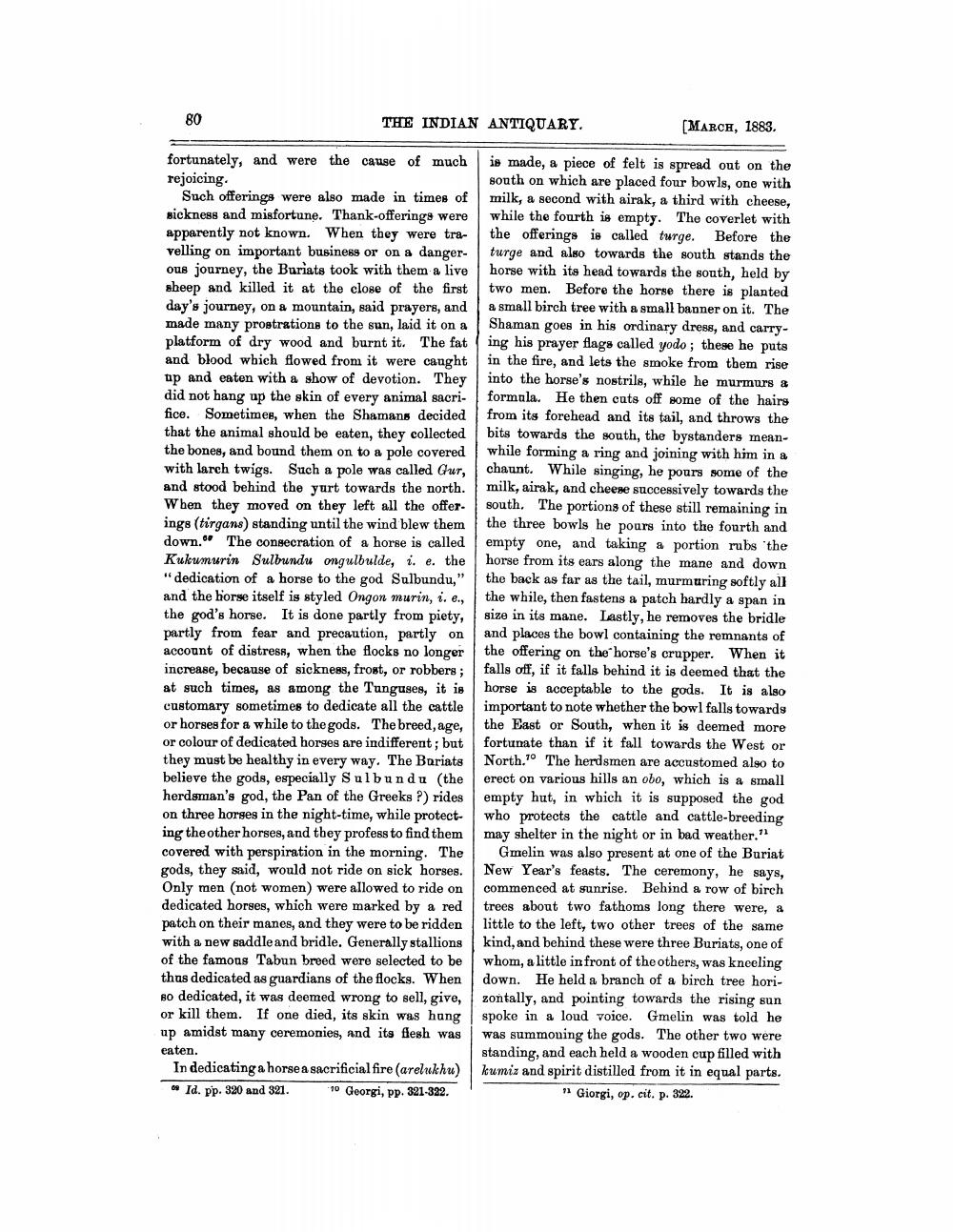________________
80
THE INDIAN ANTIQUARY.
[MARCH, 1883.
fortunately, and were the cause of much is made, a piece of felt is spread out on the rejoicing.
south on which are placed four bowls, one with Such offerings were also made in times of milk, a second with airak, a third with cheese, sickness and misfortune. Thank-offerings were while the fourth is empty. The coverlet with apparently not known. When they were tra- the offerings is called turge. Before the velling on important business or on a danger- turge and also towards the south stands the ous journey, the Buriats took with them a live horse with its head towards the south, held by sheep and killed it at the close of the first two men. Before the horse there is planted day's journey, on a mountain, said prayers, and a small birch tree with a small banner on it. The made many prostrations to the sun, laid it on a Shaman goes in his ordinary dress, and carryplatform of dry wood and burnt it. The fating his prayer flags called yodo; these he puts and blood which flowed from it were canght in the fire, and lets the smoke from them rise up and eaten with a show of devotion. They into the horse's nostrils, while he murmurs & did not hang up the skin of every animal sacri- formula. He then cuts off some of the hairs fice. Sometimes, when the Shamans decided from its forehead and its tail, and throws the that the animal should be eaten, they collected bits towards the south, the bystanders meanthe bones, and bound them on to a pole covered while forming a ring and joining with him in a with larch twigs. Such a pole was called Gur, chaunt. While singing, he pours some of the and stood behind the yurt towards the north. milk, airak, and cheese successively towards the When they moved on they left all the offer south. The portions of these still remaining in ings (tirgans) standing until the wind blew them the three bowls he pours into the fourth and down. The consecration of a horse is called empty one, and taking a portion rubs "the Kukumurin Sulbundu ongulbulde, i. e. the horse from its ears along the mane and down "dedication of a horse to the god Sulbundu," the back as far as the tail, murmuring softly all and the horse itself is styled Ongon murin, i. e., the while, then fastens a patch hardly a span in the god's horse. It is done partly from piety, size in its mane. Lastly, he removes the bridle partly from fear and precaution, partly on and places the bowl containing the remnants of account of distress, when the flocks no longer the offering on the horse's crupper. When it increase, because of sickness, frost, or robbers; falls off, if it falls behind it is deemed that the at such times, as among the Tunguses, it is horse is acceptable to the gods. It is also customary sometimes to dedicate all the cattle important to note whether the bowl falls towards or horses for a while to the gods. The breed, age, the East or South, when it is deemed more or colour of dedicated horses are indifferent; but fortunate than if it fall towards the West or they must be healthy in every way. The Bariats North. The herdsmen are accustomed also to believe the gods, especially Sulbundu (the erect on various hills an obo, which is a small herdsman's god, the Pan of the Greeks ?) rides empty hut, in which it is supposed the god on three horses in the night-time, while protect- who protects the cattle and cattle-breeding ing the other horses, and they profess to find them may shelter in the night or in bad weather." covered with perspiration in the morning. The Gmelin was also present at one of the Buriat gods, they said, would not ride on sick horses. New Year's feasts. The ceremony, he says, Only men (not women) were allowed to ride on commenced at sunrise. Behind a row of birch dedicated horses, which were marked by a red trees about two fathoms long there were, a patch on their manes, and they were to be ridden little to the left, two other trees of the same with a new saddle and bridle. Generally stallions kind, and behind these were three Buriats, one of of the famous Tabun breed were selected to be whom, a little in front of the others, was kneeling thus dedicated as guardians of the flocks. When down. He held a branch of a birch tree horiBo dedicated, it was deemed wrong to sell, give, zontally, and pointing towards the rising sun or kill them. If one died, its skin was hang spoke in a loud voice. Gmelin was told he up amidst many ceremonies, and its flesh was was summoning the gods. The other two were eaten.
standing, and each held a wooden cup filled with In dedicating a horse a sacrificial fire (arelukhu) kumiz and spirit distilled from it in equal parts. * Id. Pp. 320 and 321. 10 Georgi, pp. 321-322.
" Giorgi, op. cit. p. 322.




